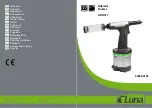
Flight manual
inter
plane
Skyboy
EX
Page 3 - 1
3
EMERGENCY PROCEDURES
Section 3 provides checklist and amplified procedures for coping with emergencies that may occur. Emergencies
caused by aeroplanes or engine malfunction are extremely rare if proper pre-flight inspections and maintenance
are practised. However, should an emergency arise, the basic guidelines described in this section should be
considered and applied as necessary to correct the problem.
ENGINE FAILURE
3.1.1
Engine failure during take-off run
1. Throttle
- decrease to idling
2. Ignition
- switch off
3. Brake
3.1.2
Engine failure during TAKE-OFF
1. Speed
- to keep gliding flight with speed 46 to 48 knots (53-56 mph or 85-90 km/h).
2. Altitude
- to altitude 80 ft ( 25 m ): land in take-off direction
- over 80 ft ( 25 m ): choose landing area
3. Course
- the best in runway direction, in free space without obstacles, with head wind
4. Fuel valve
- shut off
5. Engine igniter - switch OFF
6. Safety harness - tighten
7. Master switch - switch off before landing
8. Land
note :
3.1.3
Engine failure in flight
1. Speed
- keep gliding flight with speed 46 to 48 knots (53-56 mph or 85-90 km/h).
2. Altitude
- below altitude 80 ft (25 m ) land in take-off direction
- over 80 ft (25 m ): choose landing area
3. Wind
- evaluate direction and velocity
4. Landing area
- choose free area without obstacles
5. Course
- the best in runway direction, in free space without obstacles, with head wind
6. Fuel cock
- shut off
7. Engine igniter - switch off
8. Safety harness
- tighten
9. Master switch
- switch off before landing
10.
Land
3.1.4
Vibration
If any forced aeroplane vibrations appear, it is necessary:
1. To set engine speed to such power rating where the vibrations are lowest.
2. To land on the nearest airfield or to perform a emergency landing
Skip 6-10 if necessary










































